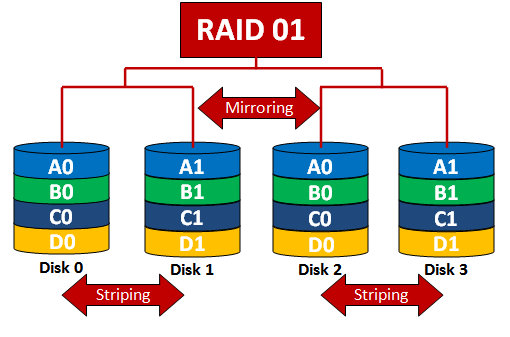Nested RAID levels
Nested RAID levels, also known as hybrid RAID, combine two or more of the standard RAID levels to gain performance, additional redundancy or both, as a result of combining properties of different standard RAID layouts
RAID 01 – Striping plus Mirroring

This provides fast data transfers by striping all data on two or more drives while mirroring that setup on an identical set of drives to provide data redundancy. An advantage is that if something goes wrong with one of the disks in a RAID 01 configuration, the rebuild time is very fast since all that is needed is copying all the data from the surviving mirror to a new drive. A disadvantage is the cost since half of the storage capacity goes to mirroring and if 1 drive is lost from each of the RAID 0 arrays, all access to data is lost.
RAID 10 – Mirroring plus Striping

This provides redundancy by mirroring all data on two drives while striping across another set of drives to speed up data transfers. An advantage is that if something goes wrong with one of the disks in a RAID 10 configuration, the rebuild time is very fast since all that is needed is copying all the data from the surviving mirror to a new drive. A disadvantage is the cost since half of the storage capacity goes to mirroring.
RAID 50 – Mirroring plus Striping with Parity

This is a bit of a misnomer. There is no RAID 0 involved with this hybrid. This provides double redundancy with very fast transfer speeds. Basically, it is a RAID 5 system mirrored to an identical RAID 5 system. This has many advantages related to all three benefits of RAIDs. The only disadvantage is the expense to set up and maintain the system.
Data Recovery from a Failed Nested RAIDs
As with any RAID system. the first thing we do is assess each individual drive. Once the initial problem for each drive has been bypassed, we make a sector by sector clone of each drive using a tool specifically designed for this process. We then take these clones and rebuild the RAID in a virtual environment. This process takes a highly skilled engineer and more specifically designed equipment and software to accomplish. The trick to this is that we often run into situations where a drive or two have failed and gone unnoticed for hours, days, or even years. The data on those drives is stale and makes the data come up as corrupt. We have to find that drive and eliminate it from the mix. The beauty of a nested RAID is that we have two chances to get full access to data. We then have access to data that can be tested for integrity and functionality.




